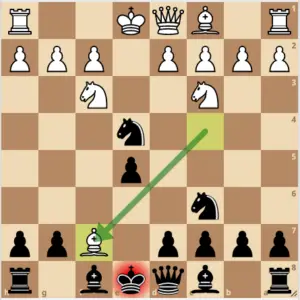One can understand why castling “through check” is illegal as the king would have to step onto an endangered square to reach the castling position. However, when it comes to castling out of check, many players including masters can’t seem to wrap their head around the logic of why it is illegal to castle out of check. After all, it’s not like the king is moving to an endangered square, right?
Well, whatever the creators were thinking when they established the law, they must have had some good reason to ommit this out of the game. But since the FIDE rules did not clearly explain why the king cannot castle out of check, all we can do is wonder and speculate.
Nevertheless, in this article, we will look at 5 plausible reasons as to why the king cannot castle out of check. We will also discuss some important steps to take in safeguarding the king in the event that it gets checked. So with that said let’s jump right in!
5 Reasons Why The King Can’t Castle Out Of Check
1. Castling Out Of Check Would Be Unfair
Since castling is already a powerful move, the “no castling out of check” rule was perhaps created to bring about some balance to the game, thereby making it fair for the player delivering check. Just imagine, if a king could simply castle out of check whenever it is in danger, then it would be unfair to the side delivering check. This means the king could stay in the center of the board for as long as it wants to until it is in danger.
This not only takes the fun out of the game, but all the principles of chess openings that we have learned over the years would be meaningless.
You could completely disregard kingsafety in the opening and still end up with a comfortable position. There would be no point in castling your king at the start of the game, and it will be harder for the attacking side to develop a feasible winning plan.
2. Castling Is A Safety Move, Not A Defensive Move
Castling originated from the king’s leap in the 14th and 15th century. This was a two square king move that was added to European chess and was later evolved into the castling we know today. Castling was a special move invented with the purpose of bringing the king to safety.
It was never meant to be made for escaping checks from the opposing side. Therefore, castling can be seen as a precautionary special move rather than a forced move to get the king out of danger.
To get the king out of check, you must either capture the piece that is delivering check, block the check with one of your pieces, or move the king out of the way. This and more we will explain further in the article.
The best approach is to prioritize castling as early in the opening so that your king can avoid checks from the opposing side. Kingside is the fastest type of castling to go for, because you just need to get your knight and bishop out. Whereas queenside castling, you have to get your knight, bishop and queen out. Not to mention, you may have to sidestep your king to further protect the outside a-pawn which will waste you more time.
3. The King Is A Slow Piece
Chess should not be seen as mere pieces moving over a checkered board. There’s meaning to the name of the pieces and how they move.
There’s a reason why the pieces are carved and given royal names such as the king, queen, bishop and knights. It’s also why the game ends when the king is checkmated because everyone knows that the king is the all sovereign, and the death of a king means the end of a monarchy.
So where am I heading with this? Well think about this, if your king is out in the battle field and an enemy soldier waves his sword at the king to chop off his head, do you think the king would have sufficient time to find a safe haven? Defintely not!
Either one of his soldiers would come to his rescue and block the attack, or try to kill and get rid of the enemy soldier. The very least the king can do is pary the attack, but he doesn’t have enough time to run far away from the threat. It’s the same as over the chessboard.
The king would have to sidestep the check by moving one square, or block the check with one of his pieces, or capture the piece delivering check.
The king is just too slow to perform castling when it’s under attack or probably he gets scared and forgets about castling.
4. The Word “Check” Has A Deeper Meaning We Overlooked
According to the oxford dictionary, the word “check” means a stopping or slowing of progress. If that definition holds true for chess, then it explains why the king cannot castle out of check as there wouldn’t be enough time to move the king two steps away and then jump the rook over beside the king.

The attacking side would have already taken down the king if he attempted to castle out of check. This would make it illegal to put your king in danger which now makes sense why the rule exists.
5. The king gets startled and can’t castle while the opponent is looking.
This is perhaps just fan fiction 🙂 But the point I am trying to make is that castling is a very special move that you cannot make whenever you feel like. It cannot be done in the presence of an attacking piece. It must be kept secret and performed when your opponent pieces aren’t looking. At least that’s the impression it give us.
Its important to note that when in check, the attention is placed on the king, not the rook. In fact, ‘check’ is just a shortening form of saying “check your king” which means “your king is in danger, you need to do something about it or it will be captured”. Over time players just learned to say the word “check” which is shorter and easier to say.
If the king is to only be involved when we say “check your king” then it would be illegal to involve the rook. And, as we stated previously, the rook wouldn’t have enough time to jump over and land next to the king.
What To Do If Your King Is In Check?
There are 3 things you can do to escape a check from the opposing side:
1. Capture The Piece Delivering Check
If a piece of yours is attacking the opponent’s piece delivering check, then your piece can capture it. This is usually the best way to get rid of the threat. Your king can also be the one to capture the piece delivering check. For example in the position below, the bishop delivered a check on f7. The black king can capture the white bishop to remove the threat completely.
The black king can capture the white bishop delivering check

2. Block the check with your piece
Blocking the check with one of your pieces is another way of removing the threat on the king. For example, this can appear in openings like the Bogo Defense which arises after the moves 1.d4 Nf6 2.c4 e6 3.Nf3 Bb4 check

Black delivered a check with his bishop on b4. There is no escape square for the white king to go, neither are there any pieces that could capture the black bishop that is delivering check. However, white has 4 pieces that can block the check and protect the king. This can be done in 5 different ways as shown by the green arrows in the image above.
3. Sidestep the king
Moving your king when in check is usually a bad thing because your king no longer has castling rights. However, there are some openings when sidestepping your king away from the check is perfectly fine to do and it doesn’t worsen the position.
But in general, moving the king in the opening can create problems with king safety and coordination of rooks. So it’s important that you have experience when going about this. However, if you are a beginner, your aim is to develop your kingside pieces quickly so that you can safely castle without being faced with annoying checks.
Final Verdict
Not being able to castle out of check is one rule that has crossed the minds of even the strongest players in the world. But I hoped that this article was able to clear up things for you. The most plausible explanation out of all 5 reasons is number 4. If we don’t understand the true definition of check, then we will be confused as to why we cannot castle out of check.
Check means the stopping or slowing of progress. Therefore if we apply this to chess, then we can understand why the king is not allowed to castle out of check. You simply wouldn’t have enough time to move your king 2 steps to the corner and then jump your rook over next to the king. It is the king that needs to be attended to quickly. Involving the rook on the battlefield would simply be too slow.


